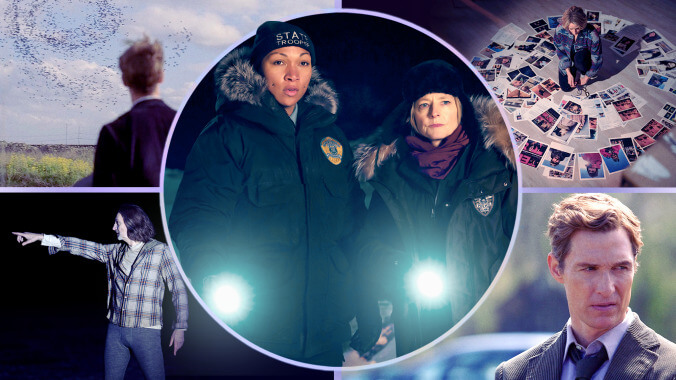Time is a flat circle: All of Night Country‘s connections to True Detective season one
That spiral symbol! The Tuttles! Creepy found footage! Here's how the current chapter of HBO's crime drama links with the first.
TV Features True Detective
True Detective: Night Country showrunner, writer, and director Issa López has told the story of how the fourth season came to be many times by now, including in an interview with The A.V. Club. She’s spoken at length about how she had a pitch ready to go when HBO came to her in search of ideas for a revival of the show, because she’d already been working on one. All she had to do was retrofit her original story about a pair of detectives investigating a mass death at an arctic research station into the universe of the show. One of the ways she did it was by going back to season one for inspiration, a “dark mirror” of the series she wanted to create.
Evidence of that influence is everywhere in Night Country. The season has all the elements that set True Detective apart from your average crime procedural: an unlikely pair of detectives, connected cases across multiple time periods, a potential criminal conspiracy, eerie atmosphere that establishes the show’s moody tone, and hints of supernatural forces at work. But it also includes more explicit references to Rust Cohle (Matthew McConaughey) and the lore of the cult that he and Marty Hart (Woody Harrelson) uncovered while trying to solve the murder of Dora Lange all those years ago.
Now that we’re coming up with theories to explain season four’s new mysteries, we thought it might be helpful to gather evidence of all the connections we’ve spotted as of episode four. Some may just be Easter eggs for the benefit of fans paying close attention, but perhaps others will offer clues to explain what happened to the men at Tsalal station, or who killed Annie K., or the links between the two cases. All we have to do is ask the right questions.

12 Comments
The opening quote, knowing it comes from a story about a woman going insane after a brain injury, seems to lead further credence to the idea that all the supernatural goings on are tied to peoples’ brains being messed with by the microorganisms disturbed by the mining and TSALAL experiments.They probably originated from the caves, with the spiral symbol being a simplification of the whale bones in the ice.
I mean, you’re not wrong about any of these. But “both of them have cases set years apart”? “Light versus dark”? Really? I know you needed to pad out the list a bit, but that’s really stretching.
Yep, they couldn’t have a slide show with only 3 or 4 slides.
Or could they? Mwah hahaha!!!
You can tell they couldn’t sell “Night Country” as its own standalone story to HBO. So instead, they shoehorn in several references to Season 1 that have *absolutely no* impact on the original story, slap “True Detective” into the title, cut a couple of filler episodes off the 8-episode order, and this is what we’re left with.
To be fair, all the seasons of True Detective are basically unrelated to each other. At least this one shares with the first in actually being good.
I wouldn’t really call this season good. It’s got a good cast and that’s about it.
I thought the 3rd season was good. Really just the 2nd season that was a dud.
This season is many things but I would not say “good” is one of them.
forgot the one eye references throughout this season and past ones.
The series creator/S1 howrunner seems to think the connections between this season and his season are ‘stupid.’ So there’s that.
Also, one single director for the season. I think that helped the consistency from episode to episode.